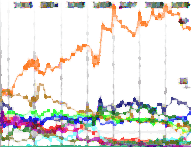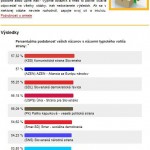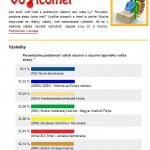![]() The last post began what will probably be a fairly discussion of how we should think about “cleavages” in the early 21st century in what we currently call post-communist Europe (a conceptual framework that becomes less relevant every year). I continue that discussion here with attention to one of the questions raised last time: The number and type of issues about which the main actors in the political system compete.
The last post began what will probably be a fairly discussion of how we should think about “cleavages” in the early 21st century in what we currently call post-communist Europe (a conceptual framework that becomes less relevant every year). I continue that discussion here with attention to one of the questions raised last time: The number and type of issues about which the main actors in the political system compete.
Today I simply begin with a list of “things that people say” and some cursory analysis. When scholars who work on Central and Eastern Europe look for the main dividing lines, whether at the level of socio-structural grouping or attitudinal/value difference, what do they tend to find?
Since there is no dominant framework, it is helpful look at commonly-used frameworks to find commonalities in assessments of “cleavage-type” divisions. It is useful to start with broad multi-national assessments before delving into the specifics of individual cases. Lijphart defines seven “issue dimensions of partisan conflict”(Patterns of Democracy, 1999, 79), many of which straddle the distinctions between socio-demographic and attitudinal categories
|
A similar starting point focusing on Central and Eastern Europe appears in a 2010 literature survey by Berglund and Ekman who refer to the findings of the 2004 Handbook of Political Change in Eastern Europe and other sources when they define ten dividing lines in three broad categories related to periods of historical development (Handbook of European Societies, 100):
Historical
Contemporary
Transitional
|
Most of these refer to “demographic” clusters. The first four recapitulate the framework established by Lipset and Rokkan, and two others in the “contemporary” list extend and nuance this list to include a more inclusive variant on “workers versus owners” and the question of generational differences. Other entries on this list–those in italics–refer not to strictly demographic questions but to value or attitudinal questions about national identity and economic distribution which are related but not necessarily identical to the demographic categories. Still others–those underlined–point more toward conflicts in the institutional realm related to party organization and party institutions. In this list Lijphart’s more issue-based dimensions of foreign policy and postmaterialism are notably absent and the question of regime type appears only in partial form in the question of “apparatus versus forums.”
The nature of the list depends not only on the regional focus but the question at hand Kitschelt makes clear distinctions between the “fabric of sociodemographic traits and relations” on one hand and “preferences for political action” on the other, though he notes that both of these shape political choice (West European Politics, 2010, 661). His assessment of the “fabric of traits” does not specify particular demographic groups, but rather identifies a list of eleven potentially important characteristics:
|
Many of these are consistent with Lipset and Rokkan’s list as used by Berglund and Ekman, but Kitschelt’s framework here moves away from identifying specific groups toward identifying specific dynamics: religiosity becomes a kind of cultural preference, while economic questions of sector and class are disaggregated into a combination of status, occupation type, income, skill, and risk exposure.
Other scholars have engaged in a similar elaboration and transformation of attitudinal and value issues, not only separating these from assumed socio-demographic mooring but also seeking to split (and sometimes recombine) key elements.
Stoll’s work on Western Europe identifies “six theoretically interesting ideological conflicts” (West European Politics, 2010, 455)
|
But even though the differences between Western and “Eastern” Europe have diminished, Stoll’s list overlaps imperfectly with the lists employed by those who research the region. Of these, perhaps the most extensive is that of Whitefield and Rohrschneider, who identify eight primarily attitudinal conflicts in their expert survey (They also identify two variants of Lipset and Rokkan’s sociodemographic divisions–regional and urban-rural–but they do not use these in much of their subsequent analysis) (Comparative Political Studies, 2009, Appendix).
|
The question, as above, is whether the long list of value differences can be conveniently shortened. The expert surveys conducted by Hooghe and Marks begin with a simple two dimensional approach which looks separately at party positions on economic issues (role in the economy, taxes, regulation, spending and welfare state) and views on democratic freedoms and rights where they differentiate Green/Alternative/Liberal (GAL) attitudes (expanded personal freedoms, for example, access to abortion, active euthanasia, same-sex marriage, or greater democratic participation) from Traditional/ Authoritarian/ Nationalist (TAN) belief that government “should be a firm moral authority on social and cultural issues” ( While these two dimensions capture much that is in the Whitefield and Rohrschneider typology–particularly their two economy questions and their religiosity and “social rights” questions–they discard important information by conflating the elements of GAL/TAN, which in postcommunist Europe tend to remain separate. Postcommunist European authoritarianism has less to do with social regulation than it does in Western Europe and more to do with democratic institutions. Postcommunist European concern about nationalism and ethnic rights is relatively independent of questions about social rights. In this sense Kitschelt offers a slightly more suitable framework when he suggests a three-fold difference that adds a “group” dimension to the dimensions for economic and cultural (“grid”) regulation:
|
Even this triple division is limiting, however, since it folds questions about democracy into the “grid” category. Empirical work by Whitefield and Rohrschnieder find that democracy questions in Postcommunist Europe tend to correlate instead with national questions, but even here evidence suggests that the connection is contingent rather than necessary (Deegan-Krause 2007), and so it is best to hold democracy separate as a fourth relevant dimension.
Nor does any of this narrowing of dimensions address the role of the Communist era, which is not quite a demographic question–though it is closely related to the shift in individuals’ respective demographic positions between the Communist and postcommunist era–and not quite a purely attitudinal question. In this it may resemble to some extent the question of religiosity, which has both ascriptive and value elements. A brief look at the region suggests that on one hand it deserves to be treated as a distinct category, since in various settings “Communism” may mean anti-market, or anti-religion, or anti-national (or pro-national), but on the other hand it is arguable that the core of the dimension lies in whatever “Communism” and “anti-Communism” ally with rather than the question of Communism itself. This, however, is an empirical question that will simply need more study.
The question of Communism, in fact, calls attention to the underlying dynamics of the political conflict. “What are they fighting about?” may be the first question we ask when we approach a new polity (or try to figure out a polity that has become opaque to us over time) but we also need to know how the struggle occurs. We need to look at the depth of the conflict and the role of political institutions in shaping the struggle.
e






 This gets a bit complicated, of course, because “nation integrating” means, “Slovak nation defending” and its rival pole is not so much “Slovak nation integrating” as “Hungarian nation defending” but I simplify it here because the main area in which Hungarian parties and Slovak parties agree on this side of the axis is the need to integrate Slovakia into European structures. Regardless of their labels, the important question is the degree to which these axes are independent of one another or somehow aligned so that positions on one are closely related to positions on the other. This is an open question in changing circumstances.
This gets a bit complicated, of course, because “nation integrating” means, “Slovak nation defending” and its rival pole is not so much “Slovak nation integrating” as “Hungarian nation defending” but I simplify it here because the main area in which Hungarian parties and Slovak parties agree on this side of the axis is the need to integrate Slovakia into European structures. Regardless of their labels, the important question is the degree to which these axes are independent of one another or somehow aligned so that positions on one are closely related to positions on the other. This is an open question in changing circumstances.


